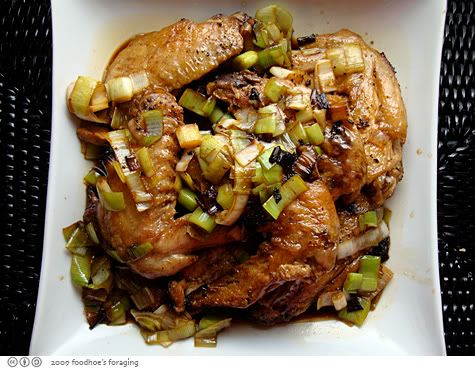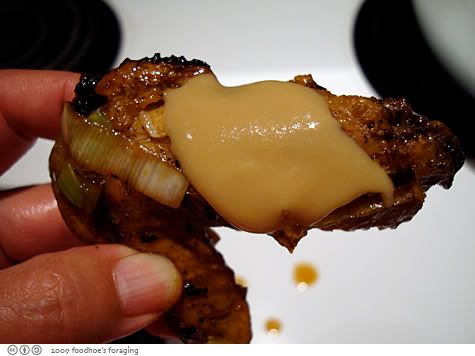
Tori teba saki no su itame
I followed Elizabeth Andoh's recipe from her book Washoku: Recipes from the Japanese Home Kitchen, for the 4th challenge of the Washoku Warriors, which was cooking with vinegar.
Serves 4 to 6
12 chicken wings or 6 chicken thighs
2 Japanese leeks or small Western leeks, or 1 yellow onion (optional)
1 teaspoon canola or other mild vegetable oil if needed
3/4 cup basic sea stock or dashi
1/4 cup sake
1/4 cup rice vinegar
2 teaspoons sugar
3 tablespoons soy sauce.
Rinse chicken pieces under cold running water. Pat the pieces dry with paper towels.
Slice the white portion of the leeks lengthwise and then cut crosswise into 1/2 inch pieces. Rinse briefly under cold water to remove any grit and drain well. Or cut the onion into 8 to 12 wedges.
Choose a skillet or saute pan that will be wide enough to hold the chicken pieces in a single layer; it does not need to be deeper than 1-1/2 inches. If you want to make this dish as lean as possible, use a nonstick skillet. The amount of oil required, if any at all, to brown the chicken pieces will depend on the fat content of the poultry. Try searing the chicken without any oil to start. It is likely that its natural fat will melt and provide sufficient lubrication But if the chicken looks in danger of scorching, drizzle the oil into the pan in a spiral pattern, working from the outer edge toward the center.

Brown the chicken pieces well on one side, then flip them and brown the other side, too. after flipping them, add the leeks or onion and allow them to brown in the chicken fat or oil. When the browned leeks or onions become very aromatic, after about 1-1/2 minutes, remove them and set aside.
Add the stock, sake, vinegar and sugar and jiggle the pan lightly to make sure the sugar dissolves. Place the lid slightly askew, swirling the pan occasionally in circular motions to ensure even cooking. Lower the heat to maintain a steady, gentle simmer and cook for about 18 minutes for wings and about 25 minutes for thighs. Check the amount of liquid every 5 minutes or so. If it is reducing too rapidly, adjust the heat and add a few spoonfuls of water or stock.

When the chicken is fall-off-the-bone tender, add the soy sauce and cook for 1 minute. There should be 1/4 to 1/2 cup liquid remaining in the pan.
Remove the pan from the heat and allow the chicken to cool in the braising liquid. It is during this cooling down period that the flavors meld and enhance on another. If you will be serving this as picnic food, discard the leek or onions and serve the chicken at room temperature. If you want to enjoy this dish warm, reheat briefly just before serving. Arrange the chicken pieces on a platter or on individual plates. Return the leeks or onion to the skillet over high heat and cook until the liquid is reduced by half. Spoon this sauce over the chicken.
The author suggests plenty of paper napkins or moist travel tissues on hand. She even suggests that you may want to set out warm wet towels, what the Japanese call oshibori (literally "the wrung out cloth").
I served it with Tart Mustard Miso Sauce.


No comments:
Post a Comment